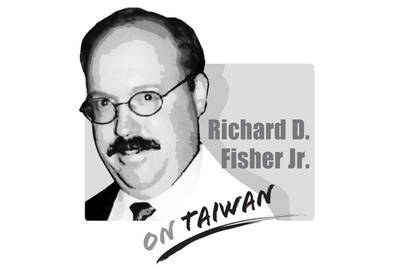Taipei's oldest food market at Jiancheng Circle was consigned to history on July 2. A massive reconstruction project to rebuild the market was undertaken after it was damaged by fire in February 1999, at a cost of as much as NT$200 million (US$6.18 million). The result was a cylindrical building of glass that had pretensions of becoming a local landmark -- but totally failed to meet practical needs.
If we examine the Taipei City Government's eight-year urban renewal plan -- from Lungshan Temple's withdrawal from an underground mall project to Shilin Night Market's poor performance since being relocated -- a great amount of government money has been spent without any result.
Taipei is inferior to major cities in neighboring countries in terms of traffic management, quality of goods, discounts for shopping and the degree of internationalization. The city government is obsessed with the number of visitors who arrive, and often ignores that a substantial improvement in tourism usually comes from an increase in the value offered to tourists. It has obliterated the humanity and history of the city, with officials only doing their development planning from inside their offices.
The hawker stalls that made up Jiancheng Circle are part of the city's history. Most of the vendors are still doing good business today in other locations nearby. Evidently, the market's poor performance was not caused by the vendors and consumers. Rather, it was the lack of parking, a poor design that had no clear lines of movement on the first two floors, as well as narrow seating areas and aisles.
Unfortunately, the city government has been unable to face the problems objectively, attempting to turn it into a promotion center for traditional food after all the food vendors left.
Food is a mixture of tradition, culture and even emotions. It cannot be replaced by festivals that look good in appearance only. Blaming the market's failure on the public is irresponsible and immoral. But worse is that the city councilors passed a huge budget and allowed the city government to ignore local residents' petition. They even claimed that the policy mistake was a result of people's outdated dining habits and different historical backgrounds. I strongly hope that the public can see through this political trickery and buck-passing.
We must demand that those councilors who claimed they were concerned about this issue take responsibility and review the failure of the market. They should not show concern only when elect-ions approach, or when vendors, housing prices and the public are already hurt. Such concern is as meaningless as the money wasted on rebuilding the market.
Lo Ying-wei is a project manager for the Taiwan Solidarity Union.
TRANSLATED BY EDDY CHANG
Concerns that the US might abandon Taiwan are often overstated. While US President Donald Trump’s handling of Ukraine raised unease in Taiwan, it is crucial to recognize that Taiwan is not Ukraine. Under Trump, the US views Ukraine largely as a European problem, whereas the Indo-Pacific region remains its primary geopolitical focus. Taipei holds immense strategic value for Washington and is unlikely to be treated as a bargaining chip in US-China relations. Trump’s vision of “making America great again” would be directly undermined by any move to abandon Taiwan. Despite the rhetoric of “America First,” the Trump administration understands the necessity of
In an article published on this page on Tuesday, Kaohsiung-based journalist Julien Oeuillet wrote that “legions of people worldwide would care if a disaster occurred in South Korea or Japan, but the same people would not bat an eyelid if Taiwan disappeared.” That is quite a statement. We are constantly reading about the importance of Taiwan Semiconductor Manufacturing Co (TSMC), hailed in Taiwan as the nation’s “silicon shield” protecting it from hostile foreign forces such as the Chinese Communist Party (CCP), and so crucial to the global supply chain for semiconductors that its loss would cost the global economy US$1

US President Donald Trump’s challenge to domestic American economic-political priorities, and abroad to the global balance of power, are not a threat to the security of Taiwan. Trump’s success can go far to contain the real threat — the Chinese Communist Party’s (CCP) surge to hegemony — while offering expanded defensive opportunities for Taiwan. In a stunning affirmation of the CCP policy of “forceful reunification,” an obscene euphemism for the invasion of Taiwan and the destruction of its democracy, on March 13, 2024, the People’s Liberation Army’s (PLA) used Chinese social media platforms to show the first-time linkage of three new
Sasha B. Chhabra’s column (“Michelle Yeoh should no longer be welcome,” March 26, page 8) lamented an Instagram post by renowned actress Michelle Yeoh (楊紫瓊) about her recent visit to “Taipei, China.” It is Chhabra’s opinion that, in response to parroting Beijing’s propaganda about the status of Taiwan, Yeoh should be banned from entering this nation and her films cut off from funding by government-backed agencies, as well as disqualified from competing in the Golden Horse Awards. She and other celebrities, he wrote, must be made to understand “that there are consequences for their actions if they become political pawns of